You crafted a new, fascinating downloadable content. Then, you designed a beautiful landing page around that and gated that content to collect e-mails and contact information to extend your CRM data. Great. Oh, also, you have subscription forms around your website that generate tens of industry professionals every week. You have hundreds of new leads coming to your website every month.
For sure, you know what to do with them.
You’ll filter, contact, and try to convert them into paying customers. But very soon, you’ll face the reality that this process won’t be great. In fact, it’ll be terrible. Even though you have a great product,
- a large portion of them won’t get back to you,
- a good portion of them won’t be interested,
- a small portion of them will be interested and will ask for time to think,
- and a tiny portion of them will jump to the conversation to make a purchase.
This process will take time because you’ll try to explain your vision and your product to these leads, schedule a meeting, wait for deals to get into a straight shape, et cetera. Also, you’ll spend a bunch of time on the operations side of this.

This is where lead nurturing comes in.
Firmly, it’s the magic that helps you insert intelligence to this process; brings inner peace to your soul by automating and intelligently managing everything, and quieter space to your prospects since you won’t be bugging them with your product right after they download an indirectly relevant eBook. But how are we going to build a lead nurturing program?
Here is how we’re gonna do it. ☝️
We’ll first start by selecting the tool we are going to use, design our value communication map, define a lead scoring strategy, create the content we’re going to use, implement everything, and connect it with the prospecting sequence. Then, of course, will measure it and improve our process. Ready? Let’s start.
Oh, by the way, here is a set of shortcuts in the article so you can directly jump to the section you want.
- Tool Selection
- Designing The Value Communication Map
- Lead Scoring
- Content Creation
- Prospecting Sequence
- Performance Measurement
- The Final Picture
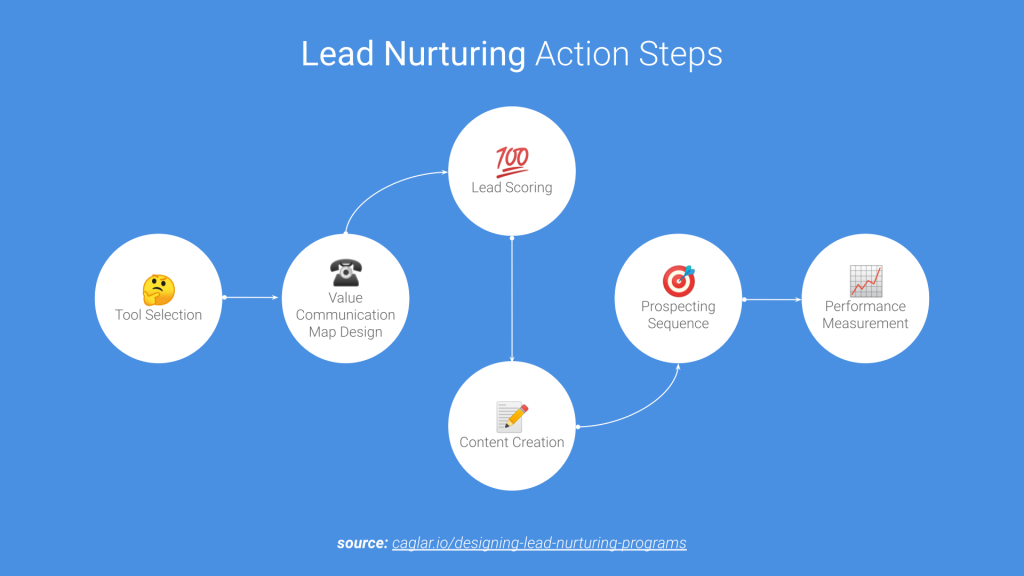
1. Tool Selection
When a digital marketer has a problem, there actually happens to be two problems. The first problem is the problem itself. The second problem spawns when marketers start thinking about how to fix it. Ideally, the best and fastest approach is going simple, leveraging the fundamentals. Whatever tools you have in your toolset, you can just implement a flow with them and test. But, since building a nurturing program is not an implement-and-go action, we should consider a long-term strategy and care about the following features;
- an automated lead scoring system,
- a functional, maybe auto-filling CRM that connects with our website via JS code,
- easy-to-use e-mail creation interface and a/b testing capabilities,
- forms that we can connect with our CRM,
- landing pages that can both integrate with our CRM and include our forms,
- ability to design workflows that can be triggered with custom activities and can change some fields in the CRM or trigger an e-mail.
That’s it.
Now, we need to make a decision. We can either take the monolithic approach or the distributed approach. I’ll detail these approaches in a blog post in detail, but want to talk about them briefly.
The monolithic approach is using one tool that will cover all of your needs (maybe 90%) on all of your digital sales and marketing efforts. Imagine using HubSpot, Marketo, Dynamics 365 Marketing, or Salesforce; where all of them cover almost all your needs on your sales and marketing activities. A little bit expensive, but compared with these big players, there are some cheaper alternatives like ActiveCampaign, GetResponse, and EngageBay. One more thing to mention – most of these products provide native integrations with other commonly used products.
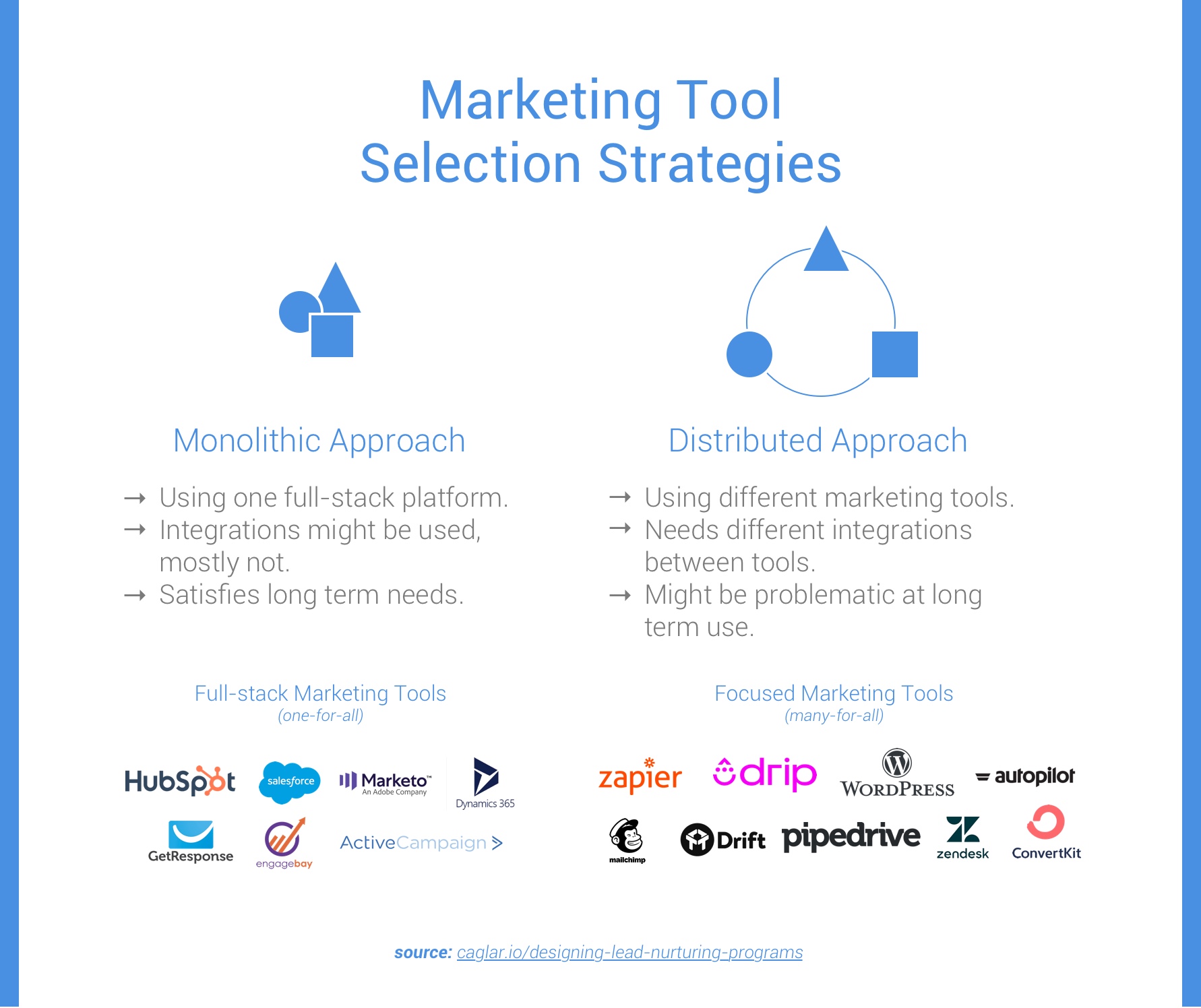
The distributed approach is using different tools for different needs and connecting them with each other. Imagine using Drip for your workflow design and e-mail campaigns, integrating it with Pipedrive, creating native forms with your WordPress website, and of course, Zapier for connecting all of them with each other. Some tools provide an integration marketplace, but not with all of the tools out there.
Honestly, I suggest going with the monolithic approach. Even if you select a cheaper option in the monolithic space, you might not have the best experience, but you will still have a good set of features that can support your activities until you generate enough revenue to migrate to another tool. I personally used EngageBay with WordPress and Zapier and HubSpot alone. Both were great options – but HubSpot all alone is an unforgettable experience that every market must taste at some time.
2. Designing The Value Communication Map
We have our setup. Now we’ll design the value communication map.
The value communication map means designing the information flow we will make our leads to go through in the beginning. Even though most of the nurturing blog posts you’ll find out there will not tell you to do something like this, I find it highly valuable to build an initial sequence to inform the prospect about your company’s vision, market, and the reason of existence. It’ll make the whole process more comfortable, and will support you on educating the market.
How are we going to design this map? In the last 20 years, the startup revolution made a unique story flow highly popular. To better understand this, I highly suggest you to read Andy Raskin mentions it by proxying Drift’s pitch, or there is an excellent presentation about perfecting sales pitches. I want you to take a few minutes to check it, so here it is.
Leveraging this pattern, I came up with a story flow that will help you whatever kind of a company you are. If your target is to change how the mechanics of the market, take the first way, and if not, take the second way.
- (if you change the market) mention the change in the market in detail,
- (otherwise) tell why your company exists,
- define a new world where problems magically disappear,
- show a customer case study where your company solves their problems,
- explain how your company supports this transformation.
At the first 3 steps, you are not selling anything. You are just trying to show an alternative world where you are consistently saying that it’s a better place to be within; and at the last step, you are showing how you support them take action and move to that better place.
I know it sounds like shenanigans, but if you leverage the right mediums, it just works. Just remember how many times you got hooked with content that had this formula.
Now, before starting working on the content, we should identify the content medium. Will we focus on developing PDF content, or blog posts, or just plain-text e-mails that include small pieces of information? That’s where your customer personas or your educated guesses about your customers will help you. But without making things more complicated, it’d be a good start to provide something digestible at the beginning like a blog post or like plain-text e-mails, and then move forward to the more investment needed content that’ll be valuable for the customer. Let’s go through an example.
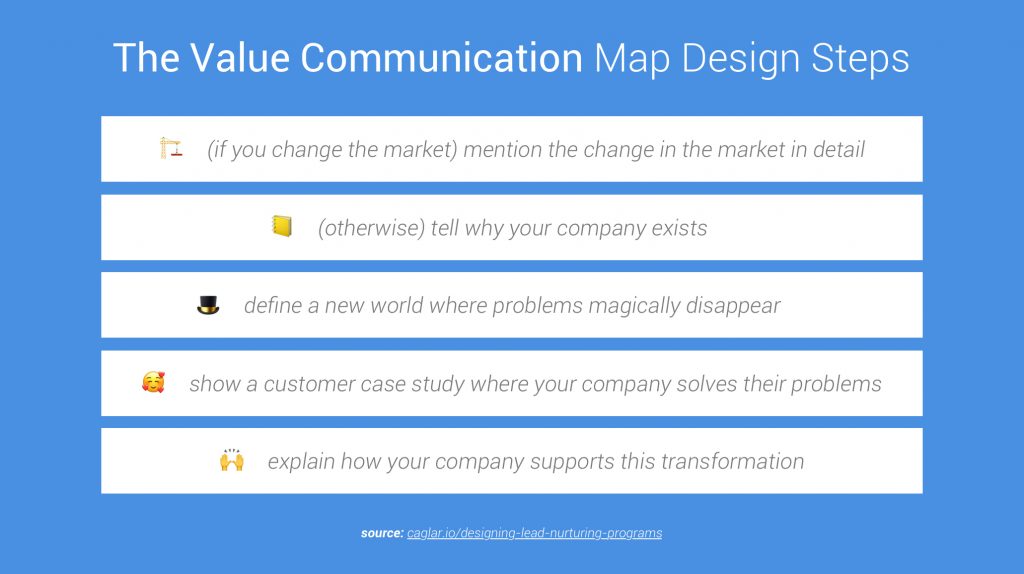
Assume I have an education company that transforms the learning experience of employees of businesses (increasing the education recall rate by 50%); so if a business uses my product, then their employees will have a better learning experience, and the business will be able to deliver more results at the same time (no additional hirings, higher productivity, et cetera.) To show the value to my leads, I’ll take the following communication actions;
- First, I’ll tell a story about how the learning experience changed within the years and how the recall rate is still low. But, there is a new way that helps improve this.
- Then, explaining the new way with a story, and showing how it helps businesses to improve their education recall rate; hence, produce real outcomes.
- While explaining the new methodology and its benefits, telling a story about how this new methodology helped a business to improve their services by showing business results.
- Here comes your entrance. Now, you come in, go through the problem briefly (again), explain why and how you solve this problem, and what your benefits are.
This will close the loop, and you’ll be able to express everything you want to show. The message might not be received, so you might need to tell these messages again on the road. But thanks to the marketing tools you are using, you’ll know which kind of content is not consumed, so you can edit them, change their types, and improve the overall process.
3. Lead Scoring
One of the most experimental parts of the lead nurturing process is lead scoring. Firmly, it is scoring leads according to their demographics and behavior to know when is the best time to reach that lead for sales purposes – trigger the prospecting sequence.
Imagine this;
- you’ll give +5 points each time a lead creates a session,
- +10 points for checking your pricing page or a case study,
- +20 points make a download,
- +5 points for having seniority of C-Level,
- -5 points for each week they are not active on your communications channels.
Thanks to our scoring strategy, we’ll know when this lead is ready for us to sell. We’ll set the goal to reach 100 points, and when a lead reaches 100 points, we’ll know they are set, and trigger the prospecting process.

Now, before moving forward – we should check what kind of information and behavior would be necessary and applicable to us. Imagine you are a Cryptocurrency company and your lead is working at a Retail company as an accountant. Would that be a good lead for you, or good leads for you have titles of CFO? That’s the demographics part. You might consider the following demographics information to filter.
- Department
- Seniority
- Company Industry
- Company Size
- Location
- Interests
Behavior is also straightforward. We’ll check users according to their behavior on all of our communication channels; our website, e-mail activity, webinars, product engagement, even physical events. Examples I mention below will give a clear idea of what kind of things these can be.
- Attending Webinars
- Watching a Demo
- Seeing a Case Study
- Checking Pricing Page
- Opening a Content on Your Product
- Reading a Blog Post
- Opening an E-mail
Now, let’s go back to our categories.
As mentioned above, there are two types of scoring. First one is demographics-based scoring, and the second one is behavior-based scoring. Demographics-based scoring will help us know if the person is the right person, and behavior-based scoring will help us understand if the person has an interest in using our product.
Before starting with designing our scoring strategy, let’s go through how we are going to collect that information. For demographic information, we can leverage the tools we already use, use data enrichment tools, embed progressive input forms to know our customers better, or use chatbots. Let’s go through them.
The first section I mentioned is the best section. HubSpot and Salesforce (others might not include) provide some necessary information according to the people’s companies. They share an estimated revenue, the number of employees, and industry – which help you to filter out the companies that don’t fit your service limitations.
The second part is using data enrichment tools. Even though they are not perfect for Turkish people (👻), data enrichment tools are great. Clearbit, for example, provides personal information like title, department, seniority, LinkedIn account, et cetera. Using this information, you can know if this person fits your target audience demographics.
The third one is personalized, progressive forms. In progressive forms (HubSpot provides this as a feature) you can ask different input questions at each time a prospect sends a submission, which allows you to gather more information at each time you have a submission from that person. Great, isn’t it?
The fourth one is the chatbots. Even though the end result is very similar to the progressive forms, since the presence and usage experience is better and they have better conversion rates, it’s a great option to consider implementing.
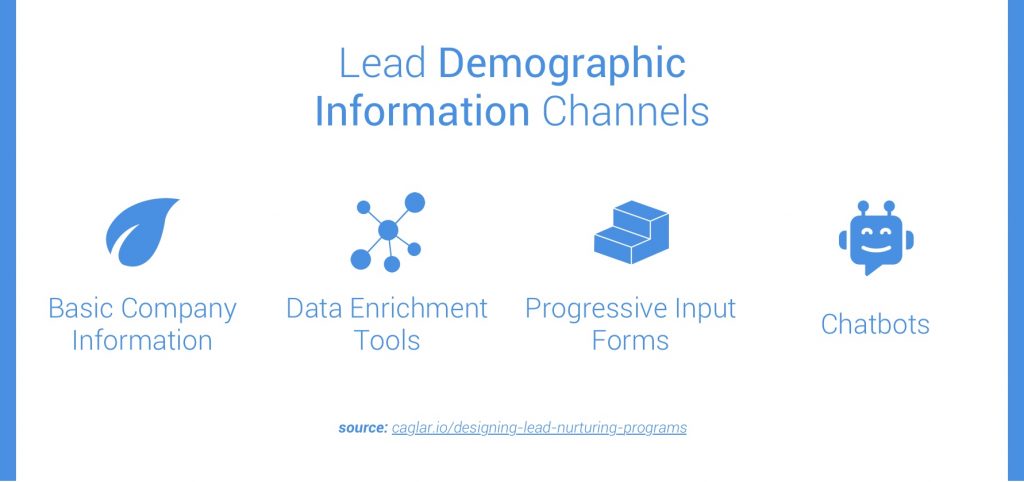
This is the demographics part. To collect behavior information and score leads according to the that, we’ll use the marketing tool we have selected. Tools which have lead scoring feature allow you to integrate their Javascript code to your website so that they can;
- Connect with your forms to move inbound leads to your CRM automatically,
- Collect their behavior on your website or integrated pages automatically.
Thanks to the power of integrations – we easily collect all the information we need, and here we are. The moment of truth.
We have the information we need – now, what are we going to do?
One thing to say is, it takes time to have a correctly working scoring algorithm. It is not being perfect until you make a few iterations. But there are two things I saw in the B2B world;
- Customer personas are highly valuable. So the demographics information of the leads must fit into the target audience. If it doesn’t, it’ll be harder for us to sell. The deal size can be low, or the sales cycle can be long, or something else.
- While old generations care about the product or the brand reputation in the market, the newer generation of buyers buys your vision. Hence, during the lead scoring, we can give generous scores on engagements with value communication activities.
Assume I have a value communication flow that consists of 2 blog posts, 1 case study, and 1 eBook. This flow will include;
- 2 Blog Post Reads
- 1 Case Study Read
- 1 eBook Download
- 4 E-mail Opens
If everything goes in the right way, I want the sum of demographical fit and value communication flow activity to hit 100. So, I’ll give 50 points to behavior and 50 points to demographics area. Considering I target C-Level / Director / Manager in Marketing departments, I can maybe come up with the following scores;
- eBook Download: +20 Points
- Reading a Case Study: +10 Points
- Reading a Blog Post: +4 Points
- Opening an E-mail: +3 Points
- C-Level Seniority: +20 Points
- Director Seniority: +15 Points
- Manager Seniority: +10 Points
- Marketing Department: +20 Points
- 10-50 Employees: +5 Points
- 50-100 Employees: +10 Points
- 100-500 Employees: +15 Points
Considering these, you can also develop your initial lead scoring algorithm. Of course, in addition to these basics, you can add extra scores to webinars, physical event attendances, or whatever activities that can be done by your leads. Here you have your initial lead scoring strategy.
4. Content Generation
Best and the easiest part, right? Here are some tips that I think would be valuable for your content development process.
- The content you’ll develop here can be SEO-focused, but you must know that people will read it – so try to be as authentic and real as you can. They are not buying your features or your product, they buy your vision. Hence, you must be real.
- Every piece of content you develop must align with your story and connect with each other. This way, you’ll not just represent a series of e-mails or pieces of content; instead, you’ll provide a story that gets better and better with each of its pieces.
- Always include influencers in your content generation process. Not on your blog posts, but asking thought leaders’ thoughts on a specific area for your eBooks would be great. They’ll add legitimacy to your content.
- Keep everything personal. Don’t send e-mails with a lot of design, or from your info e-mail address. Send it from a person’s e-mail address, in a plain-text format.
- Never stop improving your content. Always innovate them according to the feedback you collect and their conversion performance.
That’s it. Now go ahead and develop your content. Remember, never use one type of content. Try a hybrid approach, and always start with what is easy to create to begin testing quickly.
5. Prospecting Sequence
Now that our lead has reached 100 points, what are we going to do? Yes, we are ready to sell, but how should we approach to that lead? First, tag that person as an MQL, and filter out it if its company already is using you in that department, or you reached to another person within that department in a new time.
Now, we’ll design a prospecting sequence where our target will be having a call or a meeting with the relevant person within the company physically. To do that, I suggest you use Aaron Ross’ process on the book “Predictable Revenue.”
The main idea behind our prospecting sequence will be finding the right people and consistently e-mailing them to get an answer of yes or no. We want to get a clear answer. Hence, we’ll push our qualified leads for a couple of e-mails to get a clear answer.
I’m not going deep into this area also, but here are some details;
- The sender of these e-mails should be your sales team. It can be from the marketing team too, but since our target is to schedule meetings and continue the conversation, it’s better to be sent from the sales team.
- You can use Calendly or some other calendar tool to provide a more effortless scheduling experience to your prospects.
- You should have multiple prospecting sequences that are personalized for all of your target personas.
- It’s not a single channel communication process. During the prospecting, your sales team must also leverage other tools like LinkedIn, Twitter, and physical events to better connect with the prospects.
Let’s get back to the prospecting sequence e-mails. For a start, I suggest you start with a 7-step prospecting sequence. This sequence will include 5 e-mails and 2 social activities.
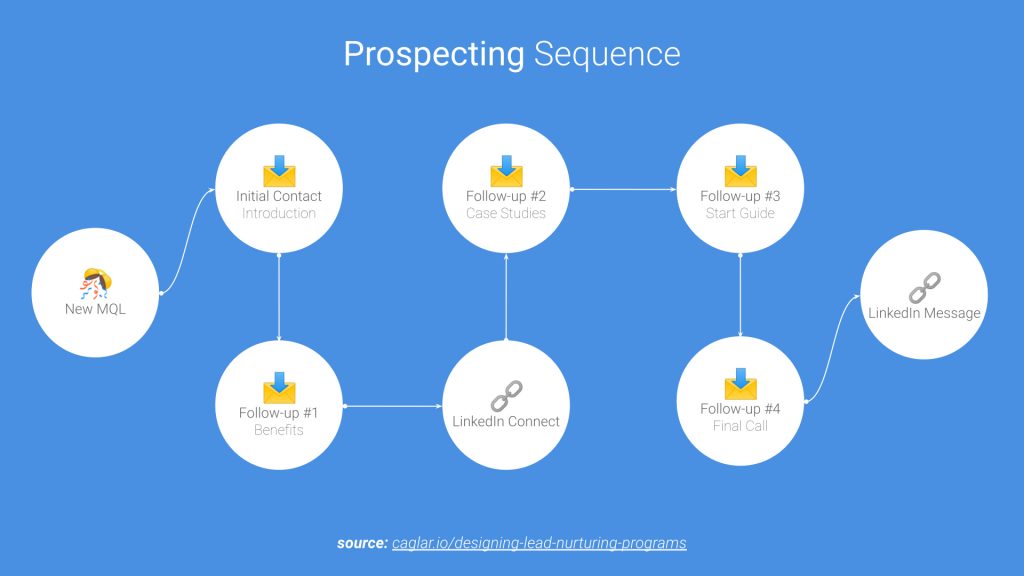
In the first e-mail, you’ll introduce who you are, explain the problem, and make a pitch for your company. Then, you’ll follow up by mentioning your product’s benefits. Afterward, you’ll connect with the prospect on LinkedIn, and share a link to case studies and customer feedback. Then, you’ll share a start guide for the transformation you bring to your customers, and then, you’ll share the last e-mail which will basically say that you are not pushing any further and you are there if they want to reach out to you.
6. Performance Measurement
Since nothing stays the same as Herakleitos mentions in his quote, “The only thing that is constant is change.”, our lead nurturing process also won’t remain the same. To understand what has changed and how we can improve, we must keep track of our nurturing process elements’ performances.
We’ll keep track of the overall performance, but we also need to see the performance of each step. Steps to watch closely are the value communication e-mails, contents we direct people to, and the prospecting sequence. The metrics? Let’s start with value overall funnel performance metrics.
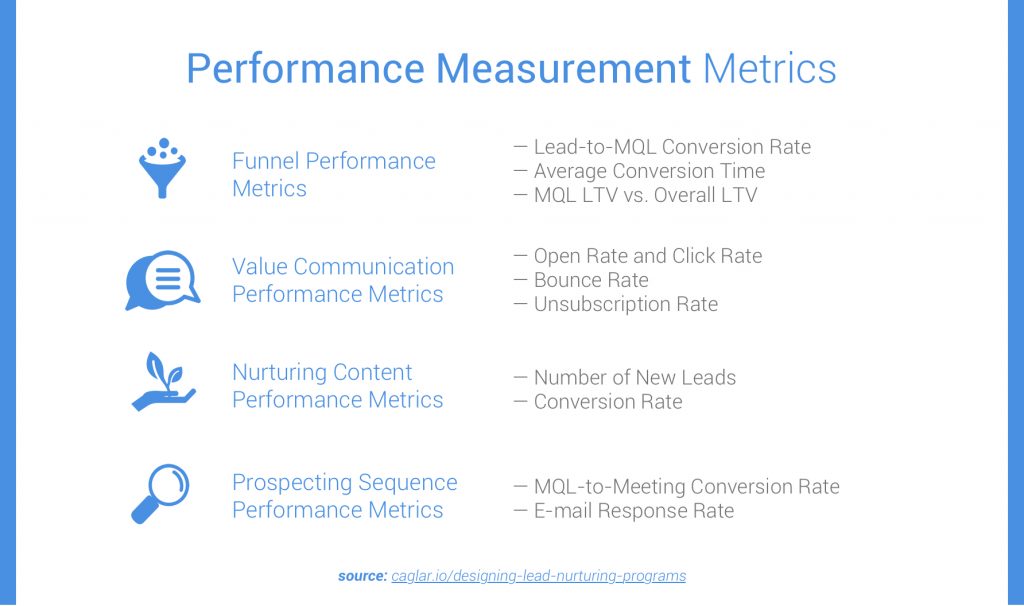
Funnel Performance Metrics
Lead-to-MQL Conversion Rate
The main target of our lead nurturing program is to turn leads into qualified leads. Hence, the primary metric we should measure is the lead-to-MQL conversion rate. This rate will allow us to measure the success of our program. To measure this, you must target an interval like 1-month or 2-months.
Average Conversion Time
We should care about the conversion time of our leads. Within your industry, you probably can guess a conversion time. Having higher conversion times with nurturing programs will be bad because either your content doesn’t drive people into making a purchase or your leads don’t fit into your audience.
MQL LTV vs. Overall LTV
Even though we generate lots of leads and maybe revenue through our nurturing converted leads, we should know their LTV to tell if the effort we put into these efforts is worth it.
Value Communication E-mail Performance Metrics
Open Rates and Click Rates of E-mails
We need to measure the open and click rates of e-mails to understand the problem area. If the open rates are low, we should improve our e-mail title, if the click rates are low, we should change the content we use in the e-mail.
Bounce Rate
If the bounce rate of our e-mails is high, then the e-mails we have collected are wrong. Hence, we need to either improve our forms by adding double opt-in or use an e-mail validation service like Kickbox to filter out bouncing e-mails.
Unsubscription Rate
Seeing unsubscription rate will allow you to see if your leads were expecting to hear from you or if you send the right amount of messages. If you see high unsubscription rates, then you should improve the experience of your forms to clarify people about their action, or add delays between your e-mails.
Nurturing Content Performance Metrics
# of New Leads
At the end of the day, the success of our content gets measured by the leads it generated within our target audience. Hence, this is our key metric to track.
Conversion Rate
To improve something, we need to know how it currently is. Knowing the conversion rates of your content will allow you to see which of your content make more sense or drive higher purchase intent to your audience, and you can work on improving them.
Prospecting Sequence Performance Metrics
MQL to Meeting Conversion Rate
Even though we have qualified the leads we have generated, our target is to schedule meetings for our sales team. Hence this is an important performance metric for us; which will show us if our prospecting sequence works.
E-mail Response Rate
Of course, we can’t schedule meetings without getting responses to our e-mails. If we have high e-mail response rates and low MQL-to-Meeting conversion rates, our content or audience has issues. If we have low e-mail response rates, then our target should be working on our e-mail content.
The Final Picture and What’s Next
We implemented our lead nurturing process successfully! During the process, as you have gone through,
- we first implemented a marketing tool to manage everything,
- designed our value communications map to tell our story step by step,
- defined scores for each lead activity to know when our leads are ready to sell,
- developed content to tell the story most effectively,
- connected the flow with our prospecting sequence,
- and iteratively improved the process by editing the flow according to our performance metrics.

Pretty cool and straightforward, right? Now you can have a drink or two, enjoy your creative work while your sales machine generates sales meetings or calls with your sales team. If you have a good lead generation process, then your sales team will love you because of all the high quality leads you to bring to them.
Now, you should bring more top-of-the-funnel content to your funnel to generate more leads to drive more people into the funnel. While doing that, if you face any troubles, please let me know. I know how it feels like not finding answers to your questions. That’s what I went through – which motivated me to write this article.

Thanks for reading! 🙌
Have questions? Comment below, DM me at @ThisIsCaglar, or e-mail to me at tokiyashi@gmail.com. What I’m writing about? I’m writing about start-ups, product design, tech-related observations, and marketing. If you want to subscribe to my adventures, subscribe here.

Leave a Reply